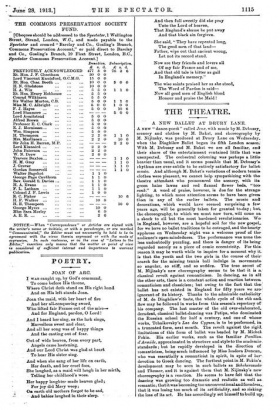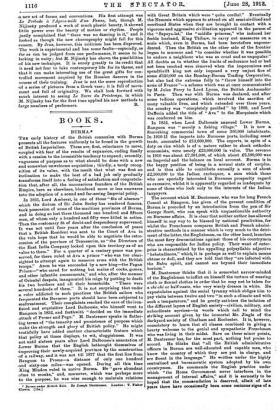THE THEATRE.
A NEW BALLET AT DRURY LANE.
A NEW " dance-poeril " called Jetta with music by M. Debussy, scenery and clothes by M. Bakst, and choreography by- M. Nijinsky, was produced at Drury Lane on Wednesday,.
when the Diaghilew Ballet began its fifth London season; With M. Debussy and H. Bakst we are all familiar, and their share of the entertainment contained little that was unexpected. The orchestral colouring was perhaps a little heavier than usual, and it seems possible that M. Debussy's.
rhythms are over-subtle to be entirely satisfactory for ballet. music. And although M. Bakst's variations of modern tennis. clothes were pleasant, we cannot help sympathizing with the theatre attendant who pronounced the scenery, with its green baize lawns and red flannel flower beds, "too. rank." A word of praise, however, is due for the strange- lighting, to which more attention seems to have been given
than in any of the earlier ballets. The music and decorations, which would have seemed surprising a few
years ago, will be generally taken for granted today; but,, the choreography, to which we must now turn, will come an a shock to all but the most hardened revolutionaries. We- in England, however, are a hopeful soil for the new gospel,.
for we have no ballet traditions to be outraged, and the hearty applause on Wednesday night was a welcome proof of the audience's open-mindedness. The performance was none the less undoubtedly puzzling, and there is danger of its being- regarded merely as a piece of comic eccentricity. For this.
reason it may be worth while to inquire for a moment why it.
is that the youth and the two girls in the course of their search for the missing tennis ball indulge in movements.
so angular, so stiff, and so sudden. The true secret of M. Nijinsky's new choreography seems to be that it is a. classical revolt against romanticism. In dancing, as in alt the other arts, there is a constant action and reaction between romanticism and classicism; but owing to the fact that the'
ballet has not existed in England for fifty years we are- ignorant of its history. Thanks to the admirable catholicity- of M. de Diaghilew's taste, the whole cycle of the ebb and.
flow may be followed in works from this season's repertory of his company. The last master of the old over-elaborated,.
decadent, classical ballet-dancing was Petipa, who dominated the Russian school for half a century, and one of whose- works, Tchaikovsky's Lac des Cygnes, is to be performed, is
a truncated form, next month. The revolt against the rigid. limitations of this form of ballet was headed by M. Michel Fokin. His earlier works, such as the familiar Pavillon. d'Arrnide, approximated in structure and style to the academic-.
standards ; but be rapidly developed in the direction of romanticism, being much influenced by Miss Isa.clora Duncan,.
who was essentially a romanticist in spirit, in spite of her
devotion to Greek dancing. The furthest point in M, Fokin's development may be seen in such ballets as Scheherazade-
and Thamar, and it is against them that IL Nijinsky's new choreography is a reaction. He seems to have felt that the dancing was growing too dramatic and realistio as well as.
romantic; that it was becoming too unconventionala,nd formless,. that it was losing too much of its artificiality, and so risking- the loss of its art. He has accordingly set himself to build up.,
a new set of forms and conventions. His first attempt was le Prelude a l'Apres-midi d'un Patine, but, though M. Nijinsky produced a work of much plastic beauty, it showed little power over the beauty of motion or rhythm. People justly complained that " there was no dancing in it," and it looked as though the new choreography might fail for this reason. By Jeux, however, this criticism has been disproved. The work is experimental and has some faults—especially, as far as can be judged from one performance, it seems to be lacking in unity ; -but M. Nijinsky has shown the poisibilities of his new technique. It is surely greatly to its credit that it need not fear to take contemporary life for its theme, and that it can make interesting use of the great gifts for con- -trolled movement acquired by the Russian dancers in the -course of their training. Aux is not the mere reproduction of a series of pictures from a Greek vase ; it is full of move- ment and full of originality. We shall look forWard with much interest to seeing Le Sacre du Printemps, in which
.
Nijinsky has for the first time applied his new methods to



























































 Previous page
Previous page